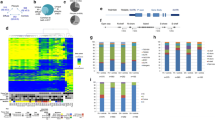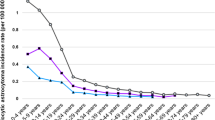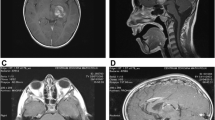Abstract
Pilocytic astrocytomas (PAs) are the most common brain tumors in pediatric patients and can cause significant morbidity, including chronic neurological deficiencies. They are characterized by activating alterations in the mitogen-activated protein kinase pathway, but little else is known about their development. To map the global DNA methylation profiles of these tumors, we analyzed 62 PAs and 7 normal cerebellum samples using Illumina 450K microarrays. These data revealed two subgroups of PA that separate according to tumor location (infratentorial versus supratentorial), and identified key neural developmental genes that are differentially methylated between the two groups, including NR2E1 and EN2. Integration with transcriptome microarray data highlighted significant expression differences, which were unexpectedly associated with a strong positive correlation between methylation and expression. Differentially methylated probes were often identified within the gene body and/or regions up- or downstream of the gene, rather than at the transcription start site. We also identified a large number of differentially methylated genes between cerebellar PAs and normal cerebellum, which were again enriched for developmental genes. In addition, we found a significant association between differentially methylated genes and SUZ12 binding sites, indicating potential disruption of the polycomb repressor complex 2 (PRC2). Taken together, these data suggest that PA from different locations in the brain may arise from region-specific cells of origin, and highlight the potential disruption of key developmental regulators during tumorigenesis. These findings have implications for future basic research and clinical trials, as therapeutic targets and drug sensitivity may differ according to tumor location.




Similar content being viewed by others
References
Armstrong GT, Conklin HM, Huang S et al (2011) Survival and long-term health and cognitive outcomes after low-grade glioma. Neuro Oncol 13:223–234. doi:10.1093/neuonc/noq178
Bert SA, Robinson MD, Strbenac D et al (2013) Regional activation of the cancer genome by long-range epigenetic remodeling. Cancer Cell 23:9–22. doi:10.1016/j.ccr.2012.11.006
Bertuzzi S, Hindges R, Mui SH, O’Leary DD, Lemke G (1999) The homeodomain protein vax1 is required for axon guidance and major tract formation in the developing forebrain. Genes Dev 13:3092–3105
Cheng Y, Sudarov A, Szulc KU et al (2010) The Engrailed homeobox genes determine the different foliation patterns in the vermis and hemispheres of the mammalian cerebellum. Development 137:519–529. doi:10.1242/dev.027045
Dirven CM, Mooij JJ, Molenaar WM (1997) Cerebellar pilocytic astrocytoma: a treatment protocol based upon analysis of 73 cases and a review of the literature. Childs Nerv Syst 13:17–23
Esteller M, Hamilton SR, Burger PC, Baylin SB, Herman JG (1999) Inactivation of the DNA repair gene O6-methylguanine-DNA methyltransferase by promoter hypermethylation is a common event in primary human neoplasia. Cancer Res 59:793–797
Forshew T, Tatevossian RG, Lawson AR et al (2009) Activation of the ERK/MAPK pathway: a signature genetic defect in posterior fossa pilocytic astrocytomas. J Pathol 218:172–181. doi:10.1002/path.2558
Gnekow AK, Falkenstein F, von Hornstein S et al (2012) Long-term follow-up of the multicenter, multidisciplinary treatment study HIT-LGG-1996 for low-grade glioma in children and adolescents of the German Speaking Society of Pediatric Oncology and Hematology. Neuro Oncol 14:1265–1284. doi:10.1093/neuonc/nos202
Gronych J, Korshunov A, Bageritz J et al (2011) An activated mutant BRAF kinase domain is sufficient to induce pilocytic astrocytoma in mice. J Clin Invest 121:1344–1348. doi:10.1172/JCI44656
Hellman A, Chess A (2007) Gene body-specific methylation on the active X chromosome. Science 315:1141–1143. doi:10.1126/science.1136352
Ichimura K, Pearson DM, Kocialkowski S et al (2009) IDH1 mutations are present in the majority of common adult gliomas but rare in primary glioblastomas. Neuro Oncol 11:341–347. doi:10.1215/15228517-2009-025
Jacob K, Quang-Khuong DA, Jones DTW et al (2011) Genetic aberrations leading to MAPK pathway activation mediate oncogene-induced senescence in sporadic pilocytic astrocytomas. Clin Cancer Res 17:4650–4660. doi:10.1158/1078-0432.CCR-11-0127
Jones DTW, Gronych J, Lichter P, Witt O, Pfister SM (2012) MAPK pathway activation in pilocytic astrocytoma. Cell Mol Life Sci 69:1799–1811. doi:10.1007/s00018-011-0898-9
Jones DTW, Ichimura K, Liu L, Pearson DM, Plant K, Collins VP (2006) Genomic analysis of pilocytic astrocytomas at 0.97 Mb resolution shows an increasing tendency toward chromosomal copy number change with age. J Neuropathol Exp Neurol 65:1049–1058. doi:10.1097/01.jnen.0000240465.33628.87
Jones DTW, Kocialkowski S, Liu L et al (2008) Tandem duplication producing a novel oncogenic BRAF fusion gene defines the majority of pilocytic astrocytomas. Cancer Res 68:8673–8677. doi:10.1158/0008-5472.CAN-08-2097
Kelly TK, de Carvalho DD, Jones PA (2010) Epigenetic modifications as therapeutic targets. Nat Biotechnol 28:1069–1078. doi:10.1038/nbt.1678
Lee DY, Gianino SM, Gutmann DH (2012) Innate neural stem cell heterogeneity determines the patterning of glioma formation in children. Cancer Cell 22:131–138. doi:10.1016/j.ccr.2012.05.036
Lindroth AM, Park YJ, McLean CM et al (2008) Antagonism between DNA and H3K27 methylation at the imprinted Rasgrf1 locus. PLoS Genet 4:e1000145. doi:10.1371/journal.pgen.1000145
Liu HK, Wang Y, Belz T et al (2010) The nuclear receptor tailless induces long-term neural stem cell expansion and brain tumor initiation. Genes Dev 24:683–695. doi:10.1101/gad.560310
Margueron R, Reinberg D (2011) The Polycomb complex PRC2 and its mark in life. Nature 469:343–349. doi:10.1038/nature09784
Ohgaki H, Eibl RH, Schwab M et al (1993) Mutations of the p53 tumor suppressor gene in neoplasms of the human nervous system. Mol Carcinog 8:74–80
Pfister S, Janzarik WG, Remke M et al (2008) BRAF gene duplication constitutes a mechanism of MAPK pathway activation in low-grade astrocytomas. J Clin Invest 118:1739–1749. doi:10.1172/JCI33656
Raabe EH, Lim KS, Kim JM et al (2011) BRAF activation induces transformation and then senescence in human neural stem cells: a pilocytic astrocytoma model. Clin Cancer Res 17:3590–3599. doi:10.1158/1078-0432.CCR-10-3349
Rasheed BK, McLendon RE, Herndon JE et al (1994) Alterations of the TP53 gene in human gliomas. Cancer Res 54:1324–1330
Rauch TA, Wu X, Zhong X, Riggs AD, Pfeifer GP (2009) A human B cell methylome at 100-base pair resolution. Proc Natl Acad Sci USA 106:671–678. doi:10.1073/pnas.0812399106
Rogers HA, Kilday JP, Mayne C et al (2012) Supratentorial and spinal pediatric ependymomas display a hypermethylated phenotype which includes the loss of tumor suppressor genes involved in the control of cell growth and death. Acta Neuropathol 123:711–725. doi:10.1007/s00401-011-0904-1
Sharma MK, Mansur DB, Reifenberger G et al (2007) Distinct genetic signatures among pilocytic astrocytomas relate to their brain region origin. Cancer Res 67:890–900. doi:10.1158/0008-5472.CAN-06-0973
Sievert AJ, Jackson EM, Gai X et al (2009) Duplication of 7q34 in pediatric low-grade astrocytomas detected by high-density single-nucleotide polymorphism-based genotype arrays results in a novel BRAF fusion gene. Brain Pathol 19:449–458. doi:10.1111/j.1750-3639.2008.00225.x
Squazzo SL, O’Geen H, Komashko VM et al (2006) Suz12 binds to silenced regions of the genome in a cell-type-specific manner. Genome Res 16:890–900. doi:10.1101/gr.5306606
Stokland T, Liu JF, Ironside JW et al (2010) A multivariate analysis of factors determining tumor progression in childhood low-grade glioma: a population-based cohort study (CCLG CNS9702). Neuro Oncol 12:1257–1268. doi:10.1093/neuonc/noq092
Sturm D, Witt H, Hovestadt V et al (2012) Hotspot mutations in H3F3A and IDH1 define distinct epigenetic and biological subgroups of glioblastoma. Cancer Cell 22:425–437. doi:10.1016/j.ccr.2012.08.024
Szulwach KE, Li X, Li Y et al (2011) 5-hmC-mediated epigenetic dynamics during postnatal neurodevelopment and aging. Nat Neurosci 14:1607–1616. doi:10.1038/nn.2959
Tchoghandjian A, Fernandez C, Colin C et al (2009) Pilocytic astrocytoma of the optic pathway: a tumour deriving from radial glia cells with a specific gene signature. Brain 132:1523–1535. doi:10.1093/brain/awp048
Yu RT, Chiang MY, Tanabe T et al (2000) The orphan nuclear receptor Tlx regulates Pax2 and is essential for vision. Proc Natl Acad Sci USA 97:2621–2625. doi:10.1073/pnas.050566897
Zhu CC, Dyer MA, Uchikawa M, Kondoh H, Lagutin OV, Oliver G (2002) Six3-mediated auto repression and eye development requires its interaction with members of the Groucho-related family of co-repressors. Development 129:2835–2849
Acknowledgments
This project was supported by grants from The Brain Tumour Charity, UK. Additional support was provided by the PedBrain Tumor Project contributing to the International Cancer Genome Consortium, funded by German Cancer Aid (109252) and by the German Federal Ministry of Education and Research (BMBF, grants #01KU1201A, MedSys #0315416C and NGFNplus #01GS0883), and the Dutch Cancer Foundations KWF (2010-4713) and KIKA to M. Kool. We thank Matthias Schick, Roger Fischer and Melanie Bewerunge-Hudler of the German Cancer Research Center (DKFZ) Genomics and Proteomics Core Facility for excellent technical support.
Author information
Authors and Affiliations
Corresponding author
Additional information
Sally R. Lambert and Hendrik Witt contributed equally to this work.
Electronic supplementary material
Below is the link to the electronic supplementary material.
Rights and permissions
About this article
Cite this article
Lambert, S.R., Witt, H., Hovestadt, V. et al. Differential expression and methylation of brain developmental genes define location-specific subsets of pilocytic astrocytoma. Acta Neuropathol 126, 291–301 (2013). https://doi.org/10.1007/s00401-013-1124-7
Received:
Revised:
Accepted:
Published:
Issue Date:
DOI: https://doi.org/10.1007/s00401-013-1124-7




